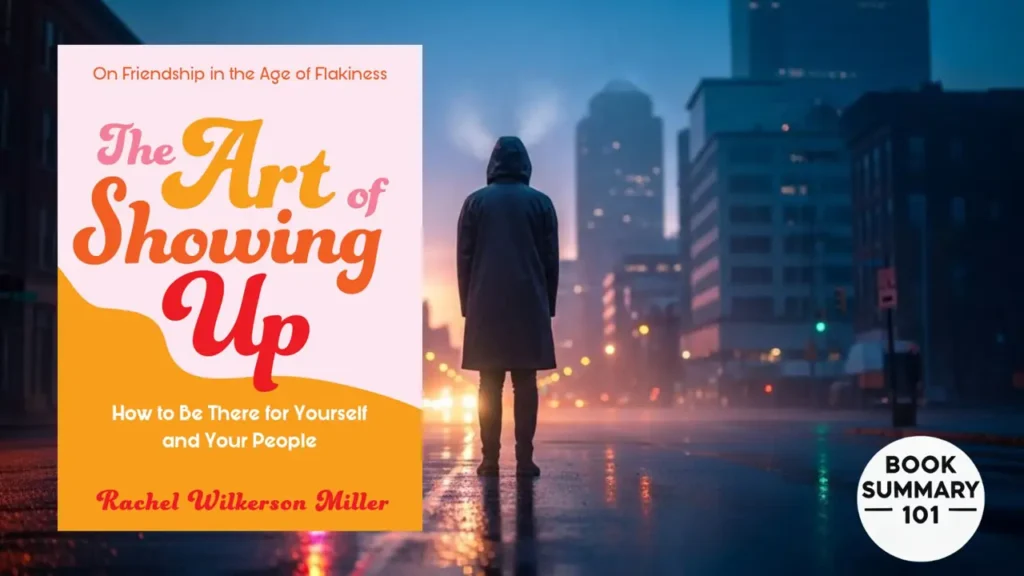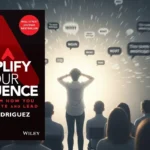Have you ever felt like you’re not really there for yourself—or even for others—in the way you’d like to be? Maybe life feels like an endless blur of tasks, and relationships, or even taking care of yourself, seem like just one more thing on the list. Rachel Wilkerson Miller’s book, The Art of Showing Up: How to Be There for Yourself and Your People, is like a breath of fresh air in this busy world. It’s a practical, insightful guide on how to truly be there, in a way that brings meaning and joy to your relationships and inner life.
Let’s dive into what makes this book a must-read for anyone who wants to learn the delicate, life-changing art of “showing up.” From tackling self-care with authenticity to being there for the people we care about, Miller’s book combines relatable stories, no-nonsense advice, and some much-needed tough love.
Why Read This Book?
At its heart, The Art of Showing Up is about connection: connection with yourself, and with others. And, let’s be honest—connection isn’t always easy. Life is busy, people can be difficult, and sometimes we’re just plain tired. Miller writes with empathy and humor, bringing both warmth and wisdom to the challenge of modern-day relationships. This book doesn’t offer cheesy self-help platitudes; instead, it’s packed with genuinely helpful advice on how to foster deep, lasting connections.
Whether you want to be a better friend, family member, or even show up for yourself in a more meaningful way, this book breaks it down into actionable, realistic steps. It’s not about being perfect; it’s about being present.
What It Really Means to Show Up
Rachel Wilkerson Miller’s The Art of Showing Up is packed with wisdom on what it really means to “show up.” It’s more than just being present physically; it’s about being emotionally, mentally, and even spiritually engaged in our lives and our relationships. Here’s a closer look at the book’s key insights and takeaways. Each section is filled with thoughtful advice and real-life scenarios to help you make lasting changes that will not only benefit you but also improve your connections with others.
Show Up for Yourself First: Prioritizing Genuine Self-Care
Miller’s first lesson is to focus on showing up for yourself. This isn’t just about indulging in feel-good activities or doing what’s trendy on social media. She argues that before we can fully be there for others, we need to have a solid foundation of self-awareness and self-care that actually sustains us.
Genuine Self-Care vs. “Feel-Good” Self-Care
Miller separates genuine self-care from the more superficial, “treat yourself” version. While bubble baths, spa days, and indulgent meals are fine, they’re only a small part of what it takes to truly take care of ourselves. Real self-care involves things like:
- Setting Boundaries: Learning when and how to say “no” so you can say “yes” to things that really matter.
- Self-Reflection: Regularly checking in with yourself and understanding what you need, how you’re feeling, and what adjustments you might need to make.
- Healthier Routines: Building daily habits—such as exercising, sleeping well, eating healthily—that fuel your body and mind.
Real-Life Example:
Consider someone who always says “yes” to work projects, even when they’re overloaded. They want to be seen as a team player, but in the process, they sacrifice their own well-being. Miller’s advice might encourage this person to set limits with work, maybe taking on only one extra project at a time. By managing their workload, they’re able to show up for themselves, and in turn, they have more energy to support their friends, family, and coworkers. Self-care in this way isn’t selfish; it’s necessary for sustainable, balanced living.
Understand Your People: Building Genuine Relationships
Once you’ve established self-care routines and boundaries, the next step is to show up for others in a meaningful way. Miller talks about the importance of truly understanding the people around us—our family, friends, and partners. She dives into how understanding the unique personalities and needs of those close to us can build more genuine, lasting relationships.
Knowing Their “Love Languages”
One of Miller’s big themes here is recognizing that everyone gives and receives love differently. She encourages readers to learn about “love languages,” a concept developed by Gary Chapman, to better understand what matters to the people they care about. Love languages can include:
- Words of Affirmation: Offering verbal support or appreciation.
- Acts of Service: Doing helpful things for someone.
- Receiving Gifts: Giving thoughtful tokens of appreciation.
- Quality Time: Spending focused, undistracted time with someone.
- Physical Touch: Offering hugs, high-fives, or gentle touch.
Empathy and Active Listening
Miller explains that true connection isn’t just about understanding love languages; it’s also about active listening. This means being fully engaged in conversations, asking thoughtful questions, and responding in a way that shows we genuinely care. Showing up for others, she argues, is about more than just “being there”—it’s about making the people in our lives feel heard and valued.
Real-Life Example:
Imagine you have a friend who’s going through a tough time, and instead of giving generic advice, you take time to listen and ask questions. You discover that what they really need is a distraction, not a solution. You suggest going out for coffee or a walk, giving them a chance to talk (or not) without pressure. Miller’s advice reminds us that being a good friend sometimes means tuning into what someone truly needs, not just what we assume they need.
Set Boundaries with Love: The Art of Saying “No” with Compassion
Setting boundaries often gets a bad reputation, but Miller insists that boundaries are the backbone of healthy relationships. Boundaries are not about rejecting others; they’re about honoring our own needs in a way that allows us to sustain positive, lasting connections. By setting boundaries, we not only preserve our own well-being but also improve the quality of our relationships.
Why Boundaries Are Essential
Without boundaries, it’s easy to feel overwhelmed, taken advantage of, or resentful. Miller explains that boundaries aren’t walls to keep people out; they’re agreements that help clarify how we want to be treated and what we’re comfortable with.
Communicating Boundaries with Clarity and Kindness
Miller offers practical scripts and advice for setting boundaries in a compassionate way. She suggests using “I” statements (e.g., “I need some quiet time in the evenings to recharge”) and staying calm, clear, and kind. Setting boundaries might mean:
- Limiting the time you spend on draining activities.
- Politely declining invitations when you’re too tired.
- Letting people know the best ways to communicate with you.
Real-Life Example:
Let’s say your friend loves to text you late at night, and it disrupts your sleep. Instead of feeling irritated or ghosting them, Miller’s approach might be to say, “I love hearing from you, but I need to keep my phone off after 9 p.m. to help me sleep better. Let’s catch up during the day instead!” This simple boundary helps protect your rest while still respecting your friendship.
Foster Real Connection in a Digital Age: Balancing Online and Offline Interactions
In a world where social media and instant messaging have become the primary ways we communicate, it’s easy to feel disconnected despite constant online “connection.” Miller’s book reminds us of the power of offline interactions—real conversations, face-to-face time, and meaningful gestures that show we care.
The Downside of Digital Connection
While staying in touch digitally can be convenient, it often lacks the depth and nuance of in-person communication. Miller explains how important it is to balance digital connection with intentional offline engagement. She encourages readers to schedule regular face-to-face time, even if it’s just a short coffee break or walk.
Intentional, Meaningful Gestures
Miller gives practical tips on how to make our relationships more meaningful. This could mean calling someone on their birthday instead of just sending a Facebook message, writing a handwritten note, or planning a meet-up instead of just “liking” their posts. She argues that small, intentional actions often carry more weight than we realize.
Real-Life Example:
Imagine you have a friend who recently moved to a new city. Instead of just texting them here and there, you could schedule regular video chats, or even surprise them with a small care package that reminds them of home. These small gestures let your friend know you’re thinking of them in a way that goes beyond casual digital interaction.
Final Thoughts: The Art of Truly “Showing Up”
The beauty of The Art of Showing Up lies in its message that showing up for ourselves and others isn’t about grand, dramatic gestures. It’s about consistent, thoughtful choices that add up to create healthier, more fulfilling connections. Miller’s advice feels refreshingly realistic: she doesn’t suggest that showing up is easy, but she does show how it’s possible, even with small steps.
If you’re feeling like your relationships could use a little extra care, or if you want to understand how to balance taking care of yourself with being there for others, this book is an inspiring and practical guide.
Join the Conversation!
Rachel Wilkerson Miller’s The Art of Showing Up is an essential read for anyone looking to deepen their relationships with themselves and others. This book is not just a guide; it’s a toolkit to help us build more fulfilling lives by cultivating real connection.
Whether you want to learn how to take better care of yourself, connect more meaningfully with others, or just navigate relationships with more confidence, Miller’s advice will resonate. So, what are your thoughts on showing up? Are there any people in your life you feel like you could show up for a little better? Or maybe you’ve realized you need to start showing up for yourself more.
Let’s talk about it! Have you read The Art of Showing Up? What were your biggest takeaways? How are you planning to show up for yourself and your people? Join the conversation!
5 powerful quotes from The Art of Showing Up by Rachel Wilkerson Miller
📖 “Showing up for yourself isn’t selfish—it’s the foundation that allows you to show up for everyone else.”
This highlights the truth that you can’t pour from an empty cup. Taking care of yourself first gives you the energy and capacity to care for others.
Simple meaning: You need to recharge yourself before you can support others.
📖 “Boundaries are not walls to keep people out—they are bridges that make connection possible without resentment.”
Miller reframes boundaries as an act of love, not rejection. They create healthier, longer-lasting relationships by making sure both sides feel respected.
Simple meaning: Boundaries protect relationships, not break them.
📖 “Listening isn’t waiting for your turn to talk; it’s giving someone the gift of your full attention.”
This reminds us that being present when others speak builds deeper trust and connection than offering quick fixes or advice.
Simple meaning: True listening means focusing on the other person, not yourself.
📖 “Small, thoughtful gestures matter more than big, occasional ones.”
A coffee date, a check-in text, or remembering something important can be more impactful than rare, dramatic efforts.
Simple meaning: Consistency in small acts shows real care.
📖 “Connection doesn’t happen by accident—it’s created when we choose to show up with intention.”
Miller emphasizes that building strong relationships requires conscious effort. It’s about choosing to engage, not just hoping it will happen.
Simple meaning: Strong bonds grow when you actively make time and effort for them.


